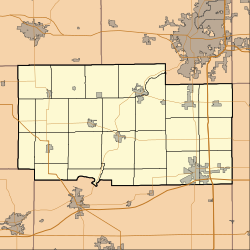Leaf River, Illinois
Leaf River | |
|---|---|
 Sign seen when entering Leaf River | |
 Location of Leaf River in Ogle County, Illinois. | |
| Coordinates: 42°07′35″N 89°24′11″W / 42.12639°N 89.40306°W | |
| Country | United States |
| State | Illinois |
| County | Ogle |
| Township | Leaf River |
| Government | |
| • Village President | Timothy Morris (R) |
| Area | |
| • Total | 0.87 sq mi (2.25 km2) |
| • Land | 0.87 sq mi (2.25 km2) |
| • Water | 0.00 sq mi (0.00 km2) |
| Elevation | 725 ft (221 m) |
| Population (2020) | |
| • Total | 432 |
| • Density | 497.12/sq mi (191.95/km2) |
| Postal code | 61047 |
| Area code | 815 |
| FIPS code | 17-42457 |
| Website | leafriver |
Leaf River is a village in Leaf River Township, Ogle County, Illinois, United States, along a stream of the same name. The population was 443 at the 2010 census, down from 555 in 2000.
Geography
[edit]Leaf River is located at 42°7′35″N 89°24′11″W / 42.12639°N 89.40306°W (42.126350, -89.402976).[2]
According to the 2010 census, Leaf River has a total area of 0.83 square miles (2.15 km2), all land.[3]
Demographics
[edit]| Census | Pop. | Note | %± |
|---|---|---|---|
| 1890 | 339 | — | |
| 1900 | 507 | 49.6% | |
| 1910 | 469 | −7.5% | |
| 1920 | 388 | −17.3% | |
| 1930 | 382 | −1.5% | |
| 1940 | 415 | 8.6% | |
| 1950 | 444 | 7.0% | |
| 1960 | 546 | 23.0% | |
| 1970 | 633 | 15.9% | |
| 1980 | 637 | 0.6% | |
| 1990 | 546 | −14.3% | |
| 2000 | 555 | 1.6% | |
| 2010 | 443 | −20.2% | |
| 2020 | 432 | −2.5% | |
| U.S. Decennial Census[4] | |||
As of the census[5] of 2000, there were 555 people, 214 households, and 154 families residing in the village. The population density was 647.6 inhabitants per square mile (250.0/km2). There were 235 housing units at an average density of 274.2 per square mile (105.9/km2). The racial makeup of the village was 98.20% White, 1.62% African American and 0.18% Native American. Hispanic or Latino of any race were 0.72% of the population.
There were 214 households, out of which 32.7% had children under the age of 18 living with them, 58.9% were married couples living together, 9.8% had a female householder with no husband present, and 28.0% were non-families. 21.5% of all households were made up of individuals, and 5.1% had someone living alone who was 65 years of age or older. The average household size was 2.59 and the average family size was 3.07.
In the village, the population was spread out, with 26.5% under the age of 18, 8.1% from 18 to 24, 29.5% from 25 to 44, 23.2% from 45 to 64, and 12.6% who were 65 years of age or older. The median age was 35 years. For every 100 females, there were 92.7 males. For every 100 females age 18 and over, there were 95.2 males.
The median income for a household in the village was $36,528, and the median income for a family was $40,268. Males had a median income of $33,958 versus $21,000 for females. The per capita income for the village was $15,620. About 2.5% of families and 5.7% of the population were below the poverty line, including 3.1% of those under age 18 and 7.6% of those age 65 or over.
Facilities
[edit]The village is the home of Camp Kupugani, a private multicultural summer camp for boys and girls.
References
[edit]- ^ "2020 U.S. Gazetteer Files". United States Census Bureau. Retrieved March 15, 2022.
- ^ "US Gazetteer files: 2010, 2000, and 1990". United States Census Bureau. February 12, 2011. Retrieved April 23, 2011.
- ^ "G001 - Geographic Identifiers - 2010 Census Summary File 1". United States Census Bureau. Archived from the original on February 13, 2020. Retrieved August 4, 2015.
- ^ "Census of Population and Housing". Census.gov. Retrieved June 4, 2015.
- ^ "U.S. Census website". United States Census Bureau. Retrieved January 31, 2008.





